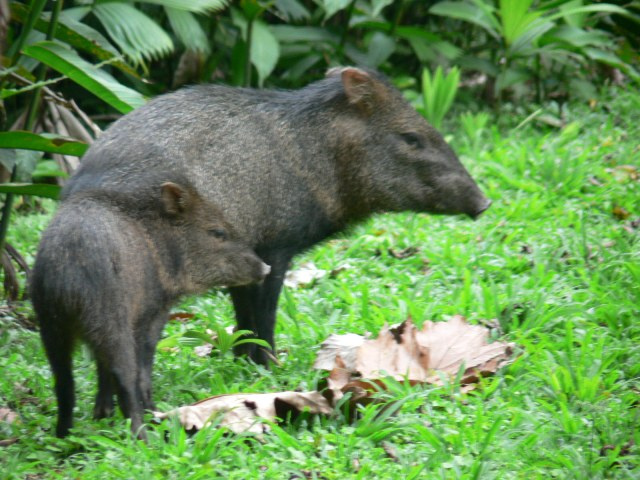
More about Collared Peccary
Habitat
Resourceful and versatile in many habitats, this peccary can survive in tropical rain forest, tropical deciduous forest, semidesert land, scrub forest, and some agricultural areas (where they are considered pests).
Range
Of North American ungulates, the collared peccary has one of the largest ranges, including from Arizona, New Mexico, and Texas down to Rio Plata in Argentina.
Physical Description
Peccaries are hunted for food and their marketable skin. When born, peccaries are reddish brown, but by adulthood they have gray-black skin covered in coarse hair that can be as long as 15.2 cm on the back. A distinct white strip around the neck makes them easily identified as "collared.'
Biology and Natural History
The peccary is very social and keeps hierarchical herds of three to thirty or more. Individuals within these groups sleep next to each other to keep warm, and are cohesive in their actions in general. Friendlier individuals rub each other, especially in greeting: each will rub its head against the scent gland on the back of the other. Peccaries make several vocalizations, including a loud bark, aggressive grumblings (especially when feeding in groups), warning tooth chattering, and purring. They may have aggressive disputes over watering holes in deciduous forests in the dry season.
Diet
In general, peccaries are not picky foragers. Peccaries eat a variety of roots, tubers, bulbs, fruits, palm nuts, and rhizomes; in agricultural areas they may also eat crops. In the rainy season, they tend to eat more leafy foliage.
Height/Weight
Central American peccaries weigh about 19.3 kg, smaller than North American peccaries. In Arizona, adults are (approximately) 14 to 27 kg and 46 to 56 cm tall at the shoulder and 89 to 97 cm long.
Taxonomy
Order: Artiodactyla
Family: Tayassidae
Sources
Eisenberg, John. Mammals of the Neotropics, Vol. 1. The University of Chicago Press: Chicago, 1989.
Sowls, L. K. in Janzen, Daniel H. Costa Rican Natural History. Chicago: University of Chicago Press, 1983.
Wilson, D. E. in Janzen, Daniel H. Costa Rican Natural History. Chicago: University of Chicago Press, 1983.
Amy Strieter, Wildlife Writer
Collared Peccary Sightings
Similar Profiles
We believe travel is more than ticking destinations off a list – it’s about discovering new places deeply, feeling connected wherever you go, and knowing you have a trusted team behind you every step of the way.



